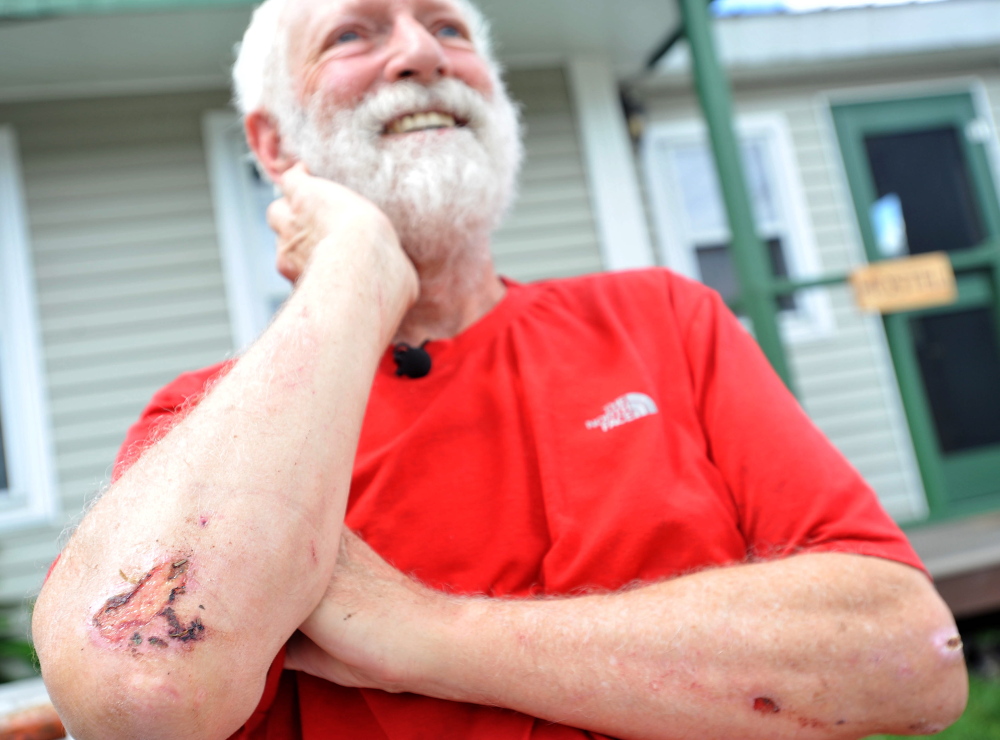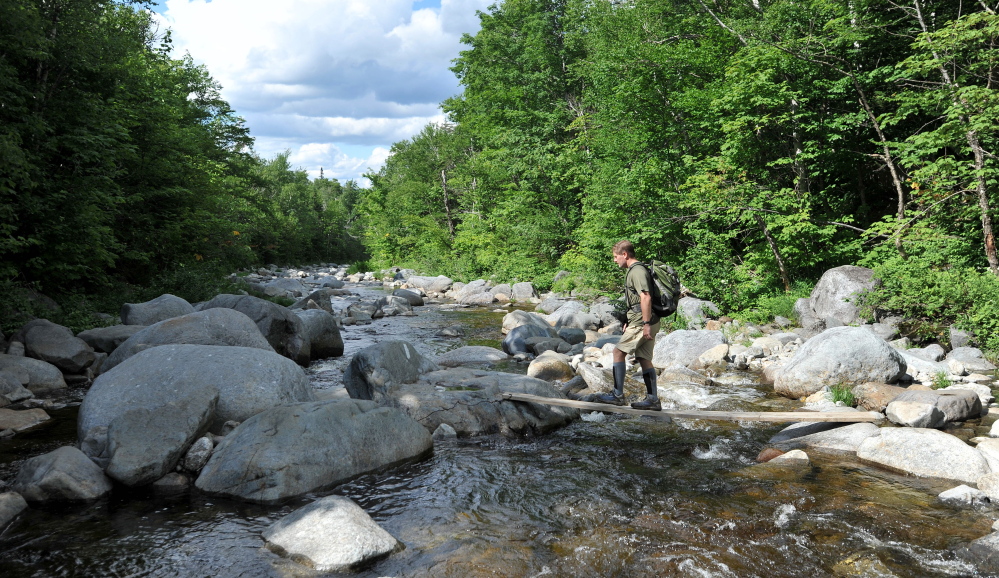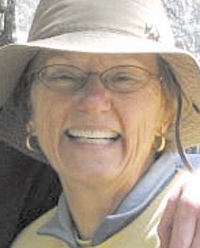STRATTON — Harold Helm has spent more than 40 years working his way along the Appalachian Trail. The 70-year-old Californian started the 2,180-mile trail in 1972 and has returned year after year for days and sometimes weeks at a time in a quest to walk its entire length.
Helm had just finished crossing the White Mountains into Gorham, N.H., last July when he heard about a hiker known as Inchworm, about 50 miles ahead of him, who had disappeared while hiking what is regarded as one of the most challenging hikes in the world.
Geraldine Largay, whose trail name was Inchworm, will have been missing for one year on Tuesday. Theories abound as to what may have happened to her and whether she is still alive, but it hasn’t stopped hikers from setting off on the same journey as the grandmother from Brentwood, Tenn.
No sign of Largay has been found despite several massive searches of the area headed by the Maine Warden Service
“It’s pretty rugged country,” said Helm, who goes by the name Slow Mosey on the trail, on Thursday. “There are parts you wouldn’t believe you can walk up, but you can. I think a lot of people aren’t mentally prepared for what you’re expected to do.”
Between 2 and 3 million people enter the trail, which runs from Georgia to Maine, every year, according to the Appalachian Trail Conservancy. That includes about 1,800 to 2,000 people who try to thru-hike, or hike the entire trail in less than 12 months.
About three weeks ago, Helm, a hiker seeking to complete the trail in parts, picked it up in Gorham, N.H. He arrived in Stratton on Thursday, both elbows badly scraped from a fall on Crocker Mountain, about six miles away.
It’s not unusual for hikers to experience minor injuries, as did Helm, or to get lost or fall off the trail, according to game wardens, locals and other hikers, but most times they are found.
As to what happened to Largay, “everybody has theories, but no one really knows,” said Dave Cota, town manager in Carrabassett Valley, just down Route 27 from Stratton. “They’ve trekked all over, been all over the trails, the AT and all of the outlying roads that intersect the trail, trails that intersect the AT trail. Unless there’s further evidence, it appears it will be left to fate for somebody to find something.”
‘DEFINITELY NOT EASY’
On Route 27 in Wyman Township, day hikers park in a small lot. A poster asking hikers to be aware of information related to Largay’s disappearance hangs above a shrine of items that have been collected for her — a wooden cross with the word “Faith” on it, a vase of wilting daisies, beads, coins and other trinkets and a statue of a man with a baby deer and small change scattered around it.
It’s the site where Largay was scheduled to meet her husband, George Largay, after spending the night at the Poplar Ridge lean-to near where she was last seen on July 22, 2013.
From the White Mountains, from where Largay would have entered Maine, she would have had to cross several of Maine’s tallest peaks including Saddleback Mountain — elevation 4,121 feet — with Spaulding Mountain, Sugarloaf and the Crockers ahead of her. From North Crocker Mountain, she would have had a steep descent, including crossing the Carrabassett River, on her way into Wyman Township.
The trail is full of rocks, roots and mud, but well-marked with white paint. Hikers, including thru-hikers, sectional and day hikers, have varying opinions on just how difficult the section is.
“We’ve both been backpacking before, so we knew what we were getting into,” said 23-year-old Connor Litchman, of Mansfield, Mass., who on Thursday was on the tail end of a 23-mile hike into Stratton with fellow thru-hiker Jason Hamner, of Tuscaloosa, Ala.
The two said they passed by the Poplar Ridge lean-to the day before, but didn’t stay there overnight because it was crowded, something that’s not unusual during the peak summer months on the trail. Maine’s 281-mile section of the trail, including the infamous Mahoosuc Notch, the 100-Mile Wilderness and the trail’s final ascent up the state’s highest peak, Mount Katahdin in Baxter State Park, is regarded by many hikers as the hardest part of the journey.
“It’s definitely not easy,” said Litchman. “Although I don’t know why you wouldn’t want to be out here. This section of the trail, along with New Hampshire, definitely take the cake for being the most magnificent.”
There has been known to be snow on the trail as late as June, and in mid-July it is soggy and muddy, creating slippery spots near many of the trail’s rocks and boulders. The day Largay disappeared, it rained heavily.
Helm, the California hiker, said it’s not uncommon for hikers to sustain minor injuries — they’re the reason he stopped his hike last year, saying his knees and elbows were scraped up from a fall on Grafton Notch.
While among the older hikers on the trail at age 70 — more than half of all thru-hikers are in their 20s according to the conservancy — Helm said the challenges are the same for everyone.
“It’s a random experience,” he said. “You can make a good choice and it’s a bad rock.”
SOLVING THE MYSTERY
Among local people who say there was a lot of discussion around Largay’s disappearance last year, the case remains a mystery, one few believe will ever be solved.
“It’s very unusual. People go missing on a regular basis — whether it is hunters, fishermen or hikers,” said Mark Humpheries, owner of Northland General Store in Stratton. “The woods are bordered by roads everywhere and whether it seems like it or not, there’s a lot of stuff around. A few people go missing per year, at least, but searchers find them.”
The search for Largay, which was headed by the Maine Warden Service and included several other agencies and hundreds of volunteers, is one of the most complex the agency has ever undertaken, according to Lt. Kevin Adam of the Maine Warden Service.
“We feel she is still up there,” Adam said Friday. “That’s why we keep searching. If I had information that she wasn’t there, I wouldn’t be searching.
“Unfortunately until she’s located and we get to the end, we’re not going to know. That frustrates a lot of people and it frustrates us, but it’s just a matter of getting the right resources in the right area.”
About 30 search and rescue calls are made from Maine’s 281-mile stretch of the trail each year, according to the warden service. Most are rescue calls made from a known location — for example, an injured hiker may call and say they are at the Chairback lean-to with a broken ankle.
Severe weather, like the rain storm Largay would have walked through, often delay hikers for up to several hours, according to Adam, and their loved ones may call and report them missing.
About 95 percent of the time, searchers find them in 12 hours. Within 24 hours, 97 percent of lost hikers are found.
Of all the people reported missing on the trail in 2013, Largay is the only one who hasn’t been found.
State police have been involved with interviews and searches and neither they nor the warden service have any information to indicate foul play, according to Adam.
“There’s just nothing there right now to say there was any criminal activity involved with her disappearance,” Adam said. “Is there a chance? Yes, but it’s just as much a chance that she planned this and she’s living in Florida right now, that she was squirreling away money and just planned to disappear.”
Complicating factors in the search for Largay include the remoteness and rugged terrain of the search area, much of which is accessible only by foot. Searchers have also had difficulty getting and transmitting information along the trail. It has been difficult to track down hikers who may have seen Largay as they continued to make their own way along the trail.
In the days immediately following Largay’s disappearance, searchers concentrated their efforts on a 24-mile long stretch of the trail from the Poplar Ridge lean-to to Route 27 in Wyman. Volunteers and others also spread out over the area, some going as far north as the trail end in Baxter State Park.
On July 24 last year, a female hiker heading south called the Stratton Motel and told the staff there that she stayed with Largay at the Spaulding Mountain lean-to Monday into Tuesday. The warden service, however, later said it had determined the reported sighting of Largay was not credible and believes “she did not make it to the Spaulding lean-to.”
The search was officially scaled back on Aug. 4, but the warden service continued to lead organized searches through October. In the winter, when trees were bare, helicopters circled the area conducting air searches.
A group of about 20 hikers from the Appalachian Long Distance Hikers Association from around the country searched in late May, concentrating on an area of Crocker Mountain where they suspected Largay may have run into bad weather on the way to meet her husband.
On June 18 this year the Warden Service led yet another ground search for Largay. Wardens plan to resume searching the area around Poplar Ridge to Oberton Stream in September, seeking to avoid hot weather and the busiest time of year for the service in terms of other searches.
While the mystery continues, so too do the hikers.
“It doesn’t seem to be stopping people,” said Dawn MacPherson-Allen, a co-owner at Shaw’s Lodging, a hiker-friendly hostel heading north on the trail in Monson. “It certainly isn’t stopping women from hiking over there, although they do ask if she was ever found.
“I think people want the mystery solved. That’s what bothers them — the fact that nothing was ever found, no backpack, no sneakers, nothing.”
Rachel Ohm — 612-2368
Send questions/comments to the editors.









